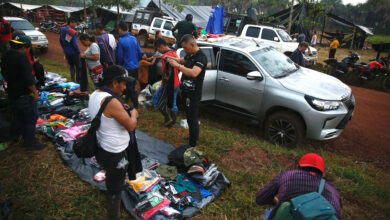Escaping Mariupol: Maria’s odyssey to reach safety

By Anastasiya Orlova
Lviv, Ukraine, May 6 (EFE).- Maria Vdovychenko, a 17-year-old high school student, managed to flee with her parents, younger sister and pet cat from Mariupol, the Ukrainian city on the shores of the Sea of Azov that before the war was the most prosperous in the eastern Donetsk region.
On February 24, the day the Russian invasion began, Maria’s mother was awoken at 3:50 a.m. by a loud explosion. She woke her children up and packed their backpacks to leave, Maria tells Efe in a video call from an unnamed European country.
But it was already too late — Russian artillery prevented them from leaving the city, where two days later the electricity and water supply was cut off.
“The first week we hid in the bathroom,” says Maria, until one day their building was struck by a missile, knocking over lamps and furniture, and the family decided to run for shelter in the basement.
“Because of the stress and because my mother suffers from polyneuropathy, she could not walk and we had to carry her,” Maria explained.
For the next 13 days, food was scarce and the family’s only source of water was by melting snow and ice. “We couldn’t sleep because we were so hungry,” she says.
Finally, they decided to leave in search of their car, as the alternative was “starving to death” or being “buried under the rubble,” as her father, Oleksandr, put it.
Upon leaving the city, at a pro-Russian checkpoint, the soldiers forced them at gunpoint into separatist territory, where the family spent 10 days in the town of Nova Yalta. They soon left after hearing that there were “cleansing operations” in which some people disappeared and others were executed on the spot.
From there they moved to Mangush, always on the lookout for safe passage to Ukrainian-controlled territory.
But to accomplish that, they would need first to pass one of the so-called “filtration centers,” where the pro-Russian forces check documents and cell phones for Ukrainian fighters or nationalist sympathies.
Maria and her family had to queue for two days without being able to leave their vehicle even to go to the toilet, in a line that only moved two to three cars per hour.
Worse still was the fate of people waiting to cross on foot, some of whom had to wait a month to get through the “filtration,” she says.
When it was the Vdovychenko family’s turn, five soldiers took Maria’s fingerprints, scanned her documents, checked her cell phone and asked her provocative questions about her political orientation.
“They were trying to find people who love their country, who want to live a normal life,” she says.
Her father had deleted all the information from his cell phone, so the soldiers began interrogating him, asking him what he was hiding. They beat him until he lost consciousness, and left him lying in the street.
After the beating, he lost sight in one eye and could barely see out of the other. As their journey continued, he had to drive slowly, dodging mines and stones, his hands trembling on the steering wheel.
Once the family was “filtered” and had obtained the appropriate certificate, they passed two separatist checkpoints and 27 Russian army checkpoints before they could reach the town of Zaporizhzhya, 200 kilometers to the west in Ukrainian-controlled territory.
At every other checkpost, Oleksandr had to undress to prove that he had no “patriotic” tattoos.
When they finally reached a Ukrainian checkpoint after a day’s walk, they first thought it was a trap, and only when they heard the soldiers speaking fluent Ukrainian did they realize that they were “finally home”.





